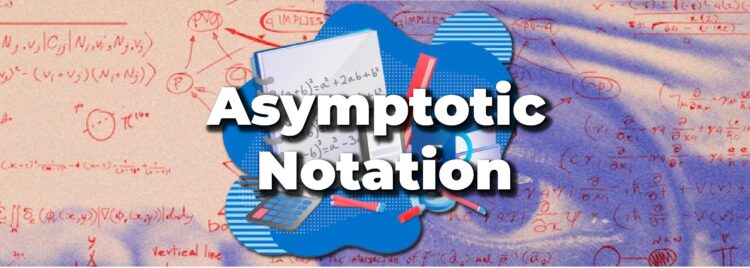Table of Contents
ToggleIntroduction
In computer science, it’s often necessary to analyze the performance of algorithms in terms of their running time and memory usage.
However, as the size of the input data increases, it can become difficult to accurately measure these metrics using precise units like seconds and bytes.
This is where asymptotic notation comes in – a way of describing the performance of algorithms in terms of how they scale with the input size rather than in concrete units.
Asymptotic notation is important for computer scientists and software developers, helping them compare algorithms and choose the most efficient solution for a given problem.
In this article, we’ll explore the basics of asymptotic notation, including the most common notations and how to use them to analyze the performance of algorithms. We’ll also discuss the limitations and potential pitfalls of asymptotic notation and provide tips for applying these concepts in practice.
Big O Notation

Big O notation is a mathematical notation used to describe the performance of an algorithm. It provides a way to measure how an algorithm’s time or space complexity grows as the size of the input increases.
In other words, it describes the worst-case scenario for how much time or memory an algorithm will require as the input size approaches infinity.
The notation is typically expressed in the form of O(f(n)), where f(n) is a function that represents the algorithm’s time or space complexity. The “O” stands for “order of,” and it indicates the upper bound of the algorithm’s growth rate.
This section will explore how to use Big O notation to analyze and compare different algorithms. We will also look at some everyday complexities and their growth rates.
Omega and Theta Notation
In addition to Big O notation, Omega notation, and Theta notation are also used in algorithm analysis. Omega notation describes the best-case time complexity of an algorithm, while Theta notation describes the average-case time complexity of an algorithm.
Omega notation is similar to Big O notation, but it provides a lower bound on the time complexity of an algorithm. Theta notation is used when an algorithm’s best and worst-case time complexity is equal.
While Big O notation provides an upper bound on the time complexity of an algorithm, Omega notation offers a lower bound.
For example, an algorithm with a worst-case time complexity of O(n^2) may have a best-case time complexity of Ω(n). This means that the algorithm will always take at least linear time to complete, but it may take significantly longer in some cases.
Theta notation is used to describe an algorithm’s average-case time complexity. When an algorithm’s best and worst-case time complexities are the same, its average-case time complexity can be characterized using Theta notation.
For example, an algorithm with a best-case time complexity of Ω(n) and a worst-case time complexity of O(n^2) has an average-case time complexity of Θ(n^2).
Omega and Theta notation is particularly useful when analyzing the time complexity of recursive algorithms or algorithms with multiple inputs.
By providing lower and upper bounds on the time complexity of an algorithm, these notations can help programmers better understand how long their code will take to run in various scenarios.
Read suggested blog: Merge Sort Algorithm
Calculating Asymptotic Notation
When it comes to calculating the asymptotic notation of an algorithm, it is important to first understand the complexity of the algorithm.
In other words, how does the algorithm’s runtime or memory usage grow as the input size increases?
The dominant term is the term that grows the fastest as the input size increases. We can ignore any lower-order terms or constant factors.
For example, consider the following algorithm:

This algorithm has a loop that runs n times, so its time complexity is O(n). We can also say that its space complexity is O(1), since it only uses a constant amount of memory.
Another example is the following algorithm
This algorithm uses a binary search to find a target element in a sorted list. Its time complexity is O(log n), since it divides the search space in half with each iteration. Its space complexity is O(1), since it only uses constant memory.
When calculating the asymptotic notation of an algorithm, it is also important to consider the worst-case scenario. This is because the worst-case scenario represents the upper bound of the algorithm’s performance.
With these principles in mind, we can calculate algorithms’ Big O, Omega, and Theta notations. By doing so, we can better understand their efficiency and scalability.
Applications of Asymptotic Notation:

Asymptotic notation is a powerful tool in computer science for analyzing and optimizing algorithms. By describing the behavior of an algorithm as the size of the input grows, the asymptotic notation can help identify performance bottlenecks and guide algorithm design choices.
Here are some of the most common applications of asymptotic notation:
- Algorithm Analysis: Asymptotic notation provides a way to compare the efficiency of different algorithms. By analyzing the worst-case time or space complexity of two algorithms using Big O notation, for example, one can determine which is more efficient for a given input size.
- Algorithm Design: Asymptotic notation can also guide the design of new algorithms. By setting an upper bound on the running time of a function using Big O notation, for example, one can design an algorithm that avoids inefficiencies and performs well even for large inputs.
- Code Optimization: Asymptotic notation can also help optimize existing code. By analyzing the asymptotic behavior of a program, one can identify performance bottlenecks and optimize the coding to improve its performance.
- Performance Tuning: Asymptotic notation can guide performance-tuning efforts. By measuring the performance of a program for different input sizes and comparing it to its asymptotic complexity, one can identify areas where further optimization is needed.
Overall, asymptotic notation is a powerful tool for analyzing and optimizing algorithms, and it is an essential part of every computer scientist’s toolbox.
By understanding how to use asymptotic notation, you can design and implement more efficient and practical algorithms for various applications.
Limitations of Asymptotic Notation

Asymptotic notation is a powerful tool for analyzing and optimizing algorithms, but it has limitations. One of the main limitations is that asymptotic notation only estimates an algorithm’s performance and does not consider real-world factors such as the hardware and operating system being used.
Another limitatio
n is that asymptotic notation assumes that the input size is large enough to dominate the complexity’s leading term. However, for small input sizes, the lower-order terms and constants can significantly impact an algorithm’s performance, even if its overall complexity is asymptotically efficient.
There are also cases where the analysis of an algorithm’s performance using asymptotic notation may not be accurate. For example, some algorithms may have irregularities or edge cases that cause them to behave differently than what would be predicted by their asymptotic notation.
Despite these limitations, asymptotic notation remains a valuable tool for analyzing and optimizing algorithms and can provide helpful insights into an algorithm’s performance, especially when used in conjunction with other performance analysis techniques.
Conclusion
Asymptotic notation is a powerful tool in computer science for analyzing and optimizing algorithms. It allows us to estimate the performance of an algorithm in terms of its input size and compare the performance of different algorithms.
However, it is important to consider the limitations of asymptotic notation, as it may not always accurately represent an algorithm’s performance in the real world.
Nonetheless, mastering asymptotic notation is an important skill for any computer scientist and can significantly aid in developing efficient and effective algorithms.
Frequently Asked Questions
What is asymptotic notation?
Asymptotic notation is a mathematical notation used to describe the performance of algorithms in terms of their input size. It provides a way to compare the efficiency of different algorithms and helps in identifying the best algorithm for a given problem.
What are the different types of asymptotic notations?
The three types of asymptotic notations are big O notation, big omega notation, and big theta notation.
What is big O notation?
Big O notation is used to describe the upper bound of an algorithm’s running time in terms of the input size. It provides an estimate of the maximum amount of time an algorithm will take to solve a problem.
What is big omega notation?
Big omega notation is used to describe the lower bound of an algorithm’s running time in terms of the input size. It provides an estimate of the minimum amount of time an algorithm will take to solve a problem.
What is big theta notation?
Big theta notation is used to describe the tight bound of an algorithm’s running time in terms of the input size. It provides an estimate of the exact amount of time an algorithm will take to solve a problem.
How do you determine the complexity of an algorithm using asymptotic notation?
To determine the complexity of an algorithm, you need to analyze its running time as the input size approaches infinity. Asymptotic notation provides a way to express this running time in terms of a simple function that captures the essence of the algorithm’s behavior.
What is the significance of asymptotic notation in algorithm analysis?
Asymptotic notation provides a standard way to compare the performance of different algorithms and helps in selecting the most efficient algorithm for a given problem.
It also provides a theoretical framework for understanding the limitations and strengths of different algorithms.
What are the limitations of asymptotic notation?
Asymptotic notation provides an estimate of an algorithm’s performance only for very large input sizes. For small input sizes, the actual running time may be dominated by other factors that are not captured by asymptotic analysis.
How is big O notation different from big omega notation?
Big O notation describes the upper bound of an algorithm’s running time, while big omega notation describes the lower bound of an algorithm’s running time.
In other words, big O notation provides an estimate of the worst-case running time, while big omega notation provides an estimate of the best-case running time.
How is big theta notation different from big O notation?
Big theta notation describes the tight bound of an algorithm’s running time, while big O notation describes the upper bound of an algorithm’s running time.
In other words, big theta notation provides an estimate of the exact running time, while big O notation provides an estimate of the worst-case running time.













